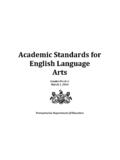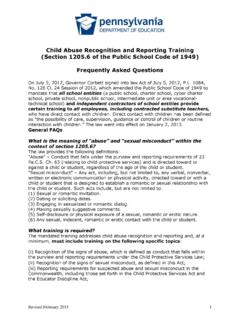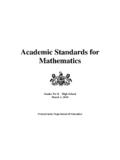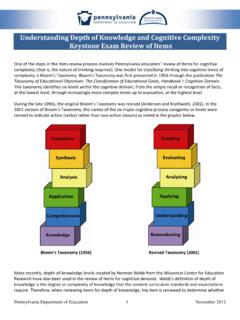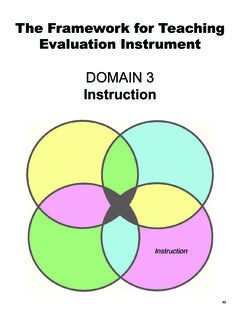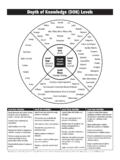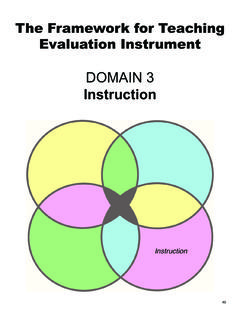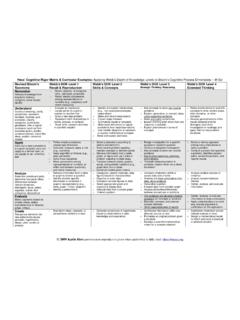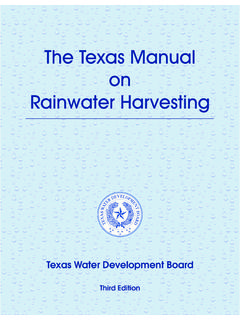Transcription of Academic Standards for Environment and Ecology - …
1 Academic Standards for Environment and Ecology June 1, 2009 FINAL. Grades 3-8, 10,12. Pennsylvania Department of Education These Standards are offered as a voluntary resource for Pennsylvania's schools and await action by the State Board of Education. The course level Standards are offered as a voluntary resource for Pennsylvania's schools. GRADES 3-8, 10, 12. Environment and Ecology X. TABLE OF CONTENTS. Introduction / Rationale . XI. THE Academic Standards . Ecology A. The Environment B. Materials Cycles C. Energy Flow D. Biodiversity E. Succession F. Science as Inquiry Watersheds and Wetlands .. A. Watersheds B. Wetlands C. Aquatic Ecosystems D. Science as Inquiry Natural Resources .. A. Use of Natural Resources B. Availability of Natural Resources C. Science as Inquiry Agriculture and Society .. A. Food and Fiber System B.
2 Importance of Agriculture C. Applying Sciences to Agriculture D. Technology Influences on Agriculture E. Science as Inquiry Humans and the Environment .. A. Sustainability B. Integrated Pest Management C. Pollution D. Waste Management E. Human Health Issues F. Science as Inquiry Glossary .. XII. 2. Draft June 1, 2009. GRADES 3-8, 10, 12. Environment and Ecology XI. INTRODUCTION. This document includes Environment and Ecology Standards that describe what students should know and be able to do in these areas: Ecology Watersheds and Wetlands Natural Resources Agriculture and Society Humans and the Environment The Declaration of Rights, Article l of the Pennsylvania Constitution states in Section 27: The people have a right to clean air, pure water, and to the preservation of the natural, scenic, historic and aesthetic values of the Environment .
3 Pennsylvania's public natural resources are the common property of all people, including generations yet to come. As trustee of these resources, the Commonwealth shall conserve and maintain them for the benefit of all the people. To this end it is our responsibility to develop a citizenry that is aware of and concerned about the total Environment and has the knowledge and skills to work toward solutions to current problems and the prevention of new ones. Environment and Ecology is grounded in the complexity of the world we live in and its sustainability. It examines the world's natural processes and systems. Environment and Ecology places its main emphasis in the real world. Allowing students to understand, through a sound Academic content base, how their everyday lives evolve around their use of the natural world and the resources it provides.
4 These Standards establish the essential elements of what students should know and be able to do at the end of grades four, seven, ten and twelve. The sequential nature of this document reflects the need for rigorous Academic content that students will be expected to achieve. The document reinforces all areas across the grade levels with increasing degrees of difficulty as the students mature intellectually. The study of Environment and Ecology will allow students to be active participants and problem solvers in real issues that affect them, their homes, schools and communities. A glossary is included to assist the reader in understanding terminology contained in the Standards . 3. Draft June 1, 2009. GRADES 3-8, 10, 12. Environment and Ecology Science as Inquiry: Understanding of science content is enhanced when concepts are grounded in inquiry experiences.
5 The use of scientific inquiry will help ensure that students develop a deep understanding of science content, processes, knowledge and understanding of scientific ideas, and the work of scientists; therefore, inquiry is embedded as a strand throughout all content areas. Teaching science as inquiry provides teachers with the opportunity to help all students in grades K-12 develop abilities necessary to understand and do scientific inquiry. These are very similar across grade bands and evolve in complexity as the grade level increases. Grades K-4 Grades 5-7 Grades 8-10 Grades 11-12. Distinguish between scientific fact and Understand how theories are developed. Compare and contrast scientific theories. Examine the status of existing theories. opinion. Identify questions that can be answered Know that both direct and indirect Evaluate experimental information for Ask questions about objects, organisms through scientific investigations and evaluate observations are used by scientists to study relevance and adherence to science processes.
6 And events. the appropriateness of questions. the natural world and universe. Judge that conclusions are consistent and Understand that all scientific investigations Design and conduct a scientific investigation Identify questions and concepts that guide logical with experimental conditions. involve asking and answering questions and understand that current scientific scientific investigations. Interpret results of experimental research to and comparing the answer with what is knowledge guides scientific investigations. Formulate and revise explanations and predict new information, propose additional already known. Describe relationships using inference and models using logic and evidence. investigable questions, or advance a solution. Plan and conduct a simple investigation prediction. Recognize and analyze alternative Communicate and defend a scientific and understand that different questions Use appropriate tools and technologies to explanations and models.
7 Argument. require different kinds of investigations. gather, analyze, and interpret data and Use simple equipment (tools and other understand that it enhances accuracy and technologies) to gather data and allows scientists to analyze and quantify understand that this allows scientists to results of investigations. collect more information than relying only Develop descriptions, explanations, and on their senses to gather information. models using evidence and understand that Use data/evidence to construct these emphasize evidence, have logically explanations and understand that scientists consistent arguments and are based on develop explanations based on their scientific principles, models, and theories. evidence and compare them with their Analyze alternative explanations and current scientific knowledge.
8 Understanding that science advances through Communicate procedures and explanations legitimate skepticism. giving priority to evidence and Use mathematics in all aspects of scientific understanding that scientists make their inquiry. results public, describe their investigations Understand that scientific investigations may so they can be reproduced and review and result in new ideas for study, new methods or ask questions about the work of other procedures for an investigation, or new scientists. technologies to improve data collection. 4. Draft June 1, 2009. GRADES 3-8, 10, 12. Environment and Ecology Content Area Strand Ecology GRADE 3 GRADE 4 GRADE 5 GRADE 6 GRADE 7 GRADE 8 GRADE 10 GRADE 12. Pennsylvania's public schools shall teach, challenge and support every student to realize his or her maximum potential and to acquire the knowledge and skills needed to: 5.
9 Draft June 1, 2009. GRADES 3-8, 10, 12. Environment and Ecology Ecology GRADE 3 GRADE 4 GRADE 5 GRADE 6 GRADE 7 GRADE 8 GRADE 10 GRADE 12. Pennsylvania's public schools shall teach, challenge and support every student to realize his or her maximum potential and to acquire the knowledge and skills needed to: Differentiate Explain how Describe the Intentionally Describe the Intentionally Examine the Analyze the between the living things are roles of Blank relationships Blank effects of significance of living and non- dependent upon producers, between biotic and limiting factors biological living other living and consumers, and abiotic on population diversity in an components in nonliving things decomposers components of an dynamics. ecosystem. an for survival. within a local ecosystem. Analyze Explain how Environment .
10 Explain what ecosystem. Compare and possible species adapt happens to an contrast different causes of to limiting organism biomes and their population factors in an when its food characteristics. fluctuations. ecosystem. supply, access Describe Explain the Analyze the to water, symbiotic and concept of differences shelter or predator/ prey carrying between The Environment space (niche / relationships. capacity in natural causes habitat) is an ecosystem. and human changed. Describe how causes of Identify organisms extinction. similarities become Research and classified as wildlife differences threatened or management between endangered. laws and their living Describe how effects on organisms, limiting biodiversity. ranging from factors cause single-celled organisms to to multi- become cellular extinct.

